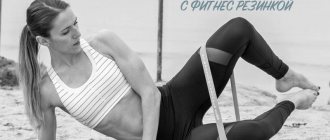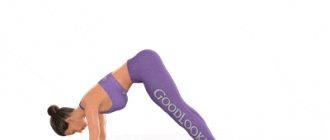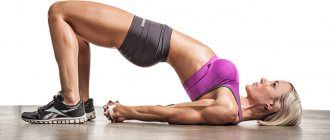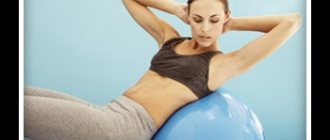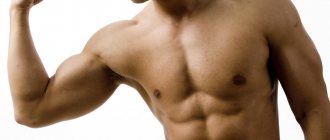No wonderful recipes or grueling diets. We act according to science: we select effective sets of exercises (exercises) for losing weight at home, the right products and do not give ourselves any concessions. This way we will get a noticeable result and be able to maintain it for a long time.
- Training and nutrition at home: how to eat if the goal is to lose weight on the sides, abdomen, hips and body tightening?
- Proper nutrition for beginners
- Workouts at home
- Morning exercises for weight loss
- Gluteal bridge
- Straight Leg Raise
- Exercise "scissors"
- Elbow to knee crunches
- Dynamic bar
- Video: Technique for performing a plank with moving hands
- Exercise "vacuum"
- Evening exercises before bed
- Squats
- Lunges
- Classic crunches
- Video: Technique for performing twists, analysis of the main mistakes
- Exercise "bicycle"
- Lying hyperextension
- Knee push-ups
- Fast charging with hula hoop
- Video: Training with different types of hoops
- Exercises with a jump rope
- Video: Exercises for training with a jump rope
Morning exercises for weight loss
We will conduct training in the morning according to a standard plan for sports activities:
- warm-up
- performing the basic set of exercises
- cool down and stretching
Running in place, leg swings and other active movements, the purpose of which is to prepare the musculoskeletal and respiratory systems for stress, are suitable as a warm-up. A criterion for the effectiveness of a warm-up can be considered a significant increase in heart rate, a rush of blood to the face and limbs, which is accompanied by a feeling of warmth, and when performing exercises in a warm and humid room, the appearance of perspiration.
Gluteal bridge
A very effective exercise for training the gluteal muscles. Its obvious advantage is that even beginners can do it without the risk of breaking the technique and causing harm to themselves. The movement is quite simple and natural, which eliminates the possibility of mistakes.
th
A simple but very effective exercise for training the gluteal muscles
The gluteal bridge is performed as follows:
- Starting position - lying on the floor, legs bent at the knees and spread shoulder-width apart, arms extended along the body or spread to the sides.
- Straining the buttocks, we raise the body so that the buttocks, lower back and part of the back to the shoulder blades come off the floor and form a straight line with the hips, while the shoulders, neck and head continue to lie on the floor.
- We linger at the highest point of the rise for 3–5 seconds, additionally straining the buttocks, then return to the starting position.
To begin with, it will be enough to do 3 sets of 10 repetitions. In the future, the number of repetitions can be increased. You can also make the task more difficult by using weights, such as a barbell or dumbbells.

For those who want quick results
Another version of the “advanced” gluteal bridge can be considered an exercise that is performed with the legs standing on a support, for example, on a bench.
Straight Leg Raise
This exercise can be performed in two different variations: lying down and hanging on a bar. Both modifications are aimed at intensively working the muscles of the lower abdominals. The option from a lying position is technically and physically easier to perform. But the second option is more suitable for experienced athletes and people in good physical shape.
Raising straight legs from a lying position is performed as follows:
- We sit on the floor face up, stretch our arms along the body.
- Raise your straight legs to a vertical position, pull your toes towards you.
- As we inhale, we lower our legs down, but do not place them on the floor; we hold them at a height of 5–15 cm above the floor.
- As you exhale, return your legs to their original position.
- Make sure your lower back is always “glued” to the floor.

Ideal exercise for working the muscles of the lower third of the abdominals
The lower you lower your legs, the more your abdominal muscles tense. You can start from a high enough starting position so as not to unnecessarily strain the muscles of the upper back and neck. As your leg strength increases, you can lower your legs lower and lower.
We do the straight leg lift while hanging on the bar like this:
- We grab the crossbar with our hands and hang on it so that our feet do not touch the floor.
- As you exhale, raise your straight legs so that they form a right angle with your body.
- Hold your legs in this position for 3–5 seconds.
- As you inhale, smoothly return your legs to their original position.
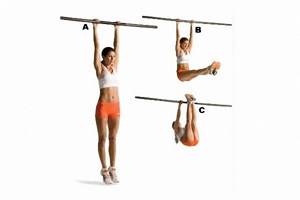
Difficult and very difficult exercise options
Those who want quick results can add one more step to the exercise. It involves raising your legs to the level of the bar. This is difficult, but quite possible with regular training. This is how the middle third of the abdominals, the front surfaces of the thighs, and the shoulder girdle are involved in the work.
We start with 3 sets of 10 repetitions. Then you can increase the number of repetitions.
Exercise "scissors"
This exercise uses the abdominal muscles and the front of the thigh.
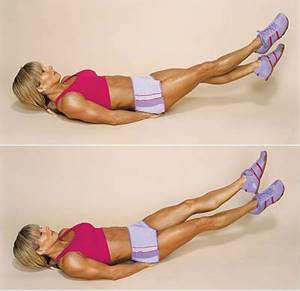
It is important to keep your legs elevated in the exercise for as long as possible
The scissors exercise is performed as follows:
- We lie on our backs, stretch our arms along the body, and place our hands under our buttocks.
- Raise your legs above the floor, pressing your lower back tightly to the mat.
- Alternately, we spread our legs to the sides and cross them, imitating the movement of scissors.
To begin with, you can perform 30 repetitions in 3 sets.
Elbow to knee crunches
Let's add load to the abdominal and hip muscles.

We strain our abs to the maximum
The exercise is performed as follows:
- Starting position - lying on your back, hands clasped at the back of your head, legs bent at the knees and spread shoulder-width apart.
- As you exhale, we begin to reach with our elbow towards the knee of the opposite leg, which we lift off the floor.
- Ideally, your elbow and knee should touch slightly.
- As you inhale, lower yourself to the starting position.
- We repeat the movement for the other side.
During the movement, only one shoulder should come off the floor. Don't pull yourself over the head trying to make the task easier. The movement should not be performed due to the muscular effort of the arms, but due to the work of the abdominal and leg muscles.
Dynamic bar
An exercise for those who are good at the static plank. For beginners, it is better to first train sufficient endurance.
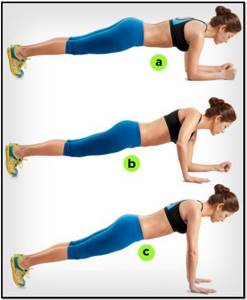
1
The dynamic plank is performed as follows (details are shown in the video):
- We stand in a plank position with emphasis on our forearms. The stomach is tucked, the buttocks are tense. The wrists are located under the shoulder joints.
- As you exhale, we rise to a position with emphasis on the palms - a classic plank.
- While inhaling, we return to the starting position.
We perform 10 repetitions in 3 approaches.
Video: Technique for performing a plank with moving hands
Exercise "vacuum"
“Vacuum” is what you need to create a perfectly flat stomach. This exercise can be used as a cool-down.
The exercise is performed as follows:
- Take as deep a breath as possible.
- We suck in our stomach and begin to exhale.
- We squeeze the air out of the lungs as much as possible, feeling how the internal organs are “sucked in” following the rising diaphragm towards the chest.
- We hold our breath for a few seconds.
- We take a gentle breath and relax.
Number of repetitions 3–5.

This is the feeling that should appear when performing the exercise correctly.
To begin with, it is better to perform the exercise while lying on your back. This is the easiest way to achieve a feeling of vacuum. Then you can do the exercise in a standing position.
Morning: “for”
Decreased appetite throughout the day
Scientists from the UK compared data from surveys conducted among runners. It turned out that those who ran in the morning felt less hungry during the day than fans of evening jogging. Scientists have suggested that morning exercise suppresses the release of hormones responsible for appetite. This means that for those who tend to overeat, after a morning workout it will be easier to cope with the habit of chewing something all the time.
It's easier to burn fat in the morning
During physical activity, carbohydrates are first consumed and only after twenty minutes of movement the muscles receive energy from fat. That is why long workouts, no shorter than 40 minutes, have always been recommended for weight loss. However, recent research from the American College of Sports Medicine shows that just 20-30 minutes of exercise in the first half of the day is enough. In terms of fat burning effect, this will be identical to 40 minutes after lunch. The reason is that until 17 o'clock in the afternoon our metabolism is set to consume energy, including fat. And after 17 hours the intensity of metabolic processes fades away, hormonal and other systems are already focused on replenishing reserves. Therefore, in the morning, stubborn fat deposits are more easily consumed.
Lower risk of injury
After a morning workout, fatigue goes away faster and muscles recover better, according to a new study from the University of Toronto. Doctors observed 3,000 people who were passionate about fitness and found that after morning training, the pulse returned to normal on average 20% faster than after evening training. In addition, a blood test showed that with the same intensity of training, microtrauma to muscle fibers and associated blood changes in the morning occur less frequently.
Evening exercises before bed
What exercises can you do before bed? Here's another exercise program to work on problem areas. The names “morning” and “evening” do not mean that you need to do two workouts a day. It is assumed that you exercise on different days, making sure to maintain sufficient intervals between workouts for muscle recovery.
It is ideal to train every other day. This is the minimum period of time sufficient to give the stressed muscles the opportunity to recover and gain mass.
By the way, girls should not be afraid of the appearance of excessive muscle relief: their natural hormonal “cocktail” helps men gain weight. All photos of muscular fitness beauties, whose figures are beginning to resemble men’s, indicate the use of drugs that affect the growth of muscle tissue (steroids and other “chemicals”). If you didn’t notice anything like that during the reception, then you shouldn’t be afraid of “oblique fathoms in the shoulders.”
Squats
There are many options for performing this exercise. Squats are distinguished:
- with its own weight;
- with weights (with dumbbells or barbell);
- using an elastic band.
Let's consider each of the options so that you can, moving from simple to complex, increase the load as your endurance and muscle strength grow.
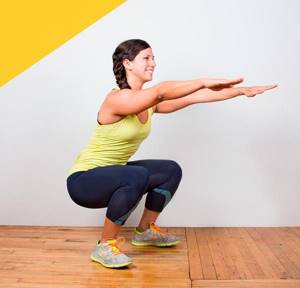
What is the best way to start training?
Classic squats are performed as follows:
- Starting position: feet shoulder-width apart, arms extended forward with palms down or along the body, elbows soft.
- As you inhale, squat until your thighs are parallel to the floor. We make sure that the knees do not extend beyond the tips of the fingers. The body moves forward slightly.
- We linger at the bottom of the squat for a couple of seconds, noting how the muscles of the buttocks and back of the thigh tighten.
- To maintain balance, you can extend your arms forward when performing a squat.
- As you exhale, we return to the starting position.
A little more difficult than regular squats is the exercise with an elastic band. Its length should be sufficient to be able to place your feet shoulder-width apart. The tape is located approximately at the level of the middle of the shins or at the level of the knees. The squat itself with an elastic band is performed in exactly the same way as a regular squat.
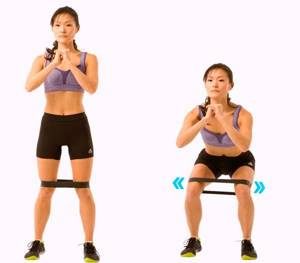
Gradually increase the load
The elastic gives additional load due to the fact that it requires additional effort to tension it between the legs.
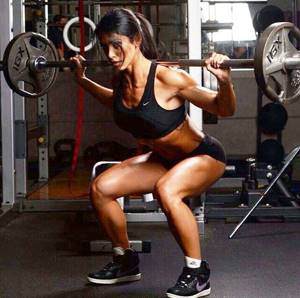
Option for advanced athletes
Using free weights can significantly increase the load on the muscles of the lower torso and legs. You can start with dumbbells or a barbell plate, then take a barbell, and then a barbell with sufficient weight. It is important to remember that the greater the weight, the more stringent the requirements for the technique of performing movements, since the risk of damaging the knee joints increases.
The number of repetitions in performing squats is not an end in itself. Don't try to do a large number of repetitions in a limited period of time. What is important here is the smoothness and thoroughness of the movements. Only a deep squat with tension in the buttocks, which is performed as if you were trying to sit on the edge of a chair that is too far behind your back, can provide optimal load on the muscles of the buttocks and ensure the ideal shape of this part of the body.
Lunges
A good workout for the leg muscles and at the same time for the cardiovascular system, since moving forward while simultaneously performing lunges is a serious load.
Lunges can be done both forward and sideways. If you don't have enough space to move around, you can use a treadmill. This will additionally set the speed of movement and will not allow you to slow down when the load begins to take its toll.
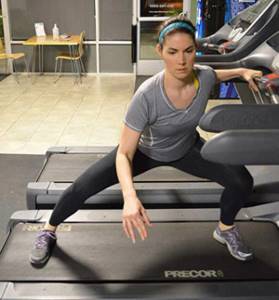
An excellent option for the fact that whoever wants is looking for opportunities
The technique of performing forward squats involves:
- Performing a sweeping step forward from a standing position. The movement is made while inhaling.
- The step should be so wide that when lowering the body, the leg that stands behind can almost touch the floor with its knee. The front shin should be perpendicular to the floor.
- While moving, keep your body perfectly straight.
- To take the next step, exhale and rise to the original position and repeat the movement.
When regular lunges no longer seem difficult, you can take dumbbells, a barbell, and then a barbell with weights. Using free weights will allow you to achieve the ideal shape of your legs in a short time.
Classic crunches
A standard and very popular abdominal exercise.
- We lie on our backs, join our hands in a lock at the back of our heads, bend our knees, which are spread shoulder-width apart, and place our feet on the floor.
- As you exhale, lift your head, neck and shoulders off the mat using the muscular force of your abs.
- We perform contractions of the abdominal muscles in such a way that the upper part of the body rises towards the legs and does not fall completely to the floor.
- While inhaling, we return to the starting position.
Video: Technique for performing twists, analysis of the main mistakes
The lifting height of the body can vary significantly. Movements of significant amplitude contribute to deep development of the middle part of the muscles of the anterior abdominal wall. Small and frequent lifts put stress on the lower third of the rectus abdominis muscle.
The number of repetitions is determined by the range of motion. You can start with 30 repetitions, divided into 3 sets, and then increase the number of repetitions.
Exercise "bicycle"
An excellent exercise that works most of the abdominal muscles at once.
How to perform the classic version of the “bicycle”:
- Starting position - lying on the floor, hands clasped at the back of the head, legs bent at the knees and hip joints so that the feet do not touch the floor.
- Raise your shoulders and upper third of your back above the floor.
- We begin to alternately reach with our elbow towards the opposite knee, while moving our legs as if we were pedaling.
- While one leg is reaching towards the elbow with the knee, the other must be straightened and kept at some distance from the floor.
We start with 10 repetitions in 3 approaches.

Hard, but very effective
Lying hyperextension
We form the ideal shape of the back, get rid of fatty “rolls” in the lumbar region.
Hyperextension is performed as follows:
- We lie face down on the floor, stretch our arms in front of us or place our palms behind our heads.
- As you exhale, simultaneously lift your arms, upper torso and legs off the floor.
- Hold this position for 3-5 seconds.
- Without releasing muscle tension, we return to the starting position.
We start with 10 repetitions.
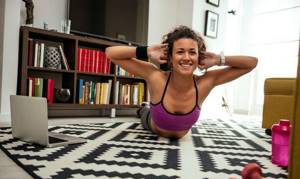
The effect of the exercise can be obtained without any exercise equipment
If we talk about hyperextension, then the smoothness of movements is important. Do not strain your lower back unnecessarily: gently raise yourself above the floor and lower yourself smoothly.
Knee push-ups
Exercise to develop the muscles of the shoulder girdle and upper back.
Push-ups are performed as follows:
- Starting position: hands slightly wider than shoulders; the back, buttocks and hips are located in one line, the legs rest with their knees on the floor.
- As you inhale, lower your body almost until your chest touches the floor.
- As you exhale, push yourself up, straightening your arms.
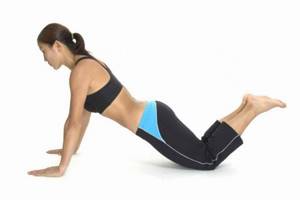
Making the body harmonious
We start with 10 repetitions and 3 approaches. The number of repetitions can then be varied depending on endurance and training goals.
Video
For hips
A reverse bridge helps to tone them up. You need to lie on your back, bend your knees, raise your pelvis, hands on the floor or holding your ankles, shoulders pressed to the mat. Hold the body for 30 seconds, gradually increasing the time. A fat-burning exercise for the buttocks will be squatting with legs spread apart so that the line of the hips forms the letter “P” with the right and left shins - 15 times, 3 repetitions. Perform lunges with a backward swing: the right leg is a step forward, the weight is transferred to it, the left leg is parallel to the floor. Then the sides change. Per leg: 15 lunges, 3 reps.
Fast charging with hula hoop
It is unlikely that hula hoop exercises can be considered an independent type of training; rather, they are of an auxiliary nature. Although you should not underestimate the capabilities of a hoop in shaping a thin waist. Intensive massage of problem areas can work wonders, provided that other conditions for effective weight loss are met.
Video: Training with different types of hoops
You shouldn’t start training with a very heavy hula hoop, as it will simply fall down without having time to really unwind. To begin with, a hoop weighing 800–1200 g will be enough.
Pay attention to the massage “pimples” on the inside of the hoop. For beginners, models with soft rubber massage ridges are suitable. And even to use such models at first, you may need a special wide belt, which somewhat softens the effect of “pimples” on the skin of the abdomen and reduces discomfort.
We start spinning the hoop at a time that is comfortable for you, and gradually increase the training time to 15–20 minutes.
Proper nutrition
Proper nutrition means healthy foods and clean water. Eliminate fatty, smoked, flour and highly salted foods from your diet. They can be replaced with equally delicious steamed dishes.
And for greater results, increase your consumption of fruits, berries and dairy products. This diet will help you get in shape and maintain a healthy and attractive body.
Exercise and proper nutrition complement each other, enhancing the effect of each. To lose weight you need to drink more water, eat light healthy foods and follow a daily routine. Only such a complex will quickly bring results and help preserve them for a long time.
Exercises with a jump rope
Jumping rope is an excellent cardio workout, during which the load is applied to all significant muscle groups. The legs, back, stomach, arms and shoulder girdle are involved.
For beginners, it’s better to take a regular jump rope and not chase “professional” weighted models. It’s better to start training with 1–3 minutes, depending on how you feel and the pace of movement. In the future, the duration of the lesson can be increased to 15–20 minutes, and then begin to gradually increase the speed of movements.
Video: Exercises for training with a jump rope
If you set a goal, you can diversify a 15-minute workout with a jump rope by performing exercises to develop balance and coordination of movements.
Exercises with a hula hoop and a jump rope can be used as a warm-up or for simple training on rest days after performing the main sets of exercises (morning and evening).
As you can see, keeping yourself in shape with the proper level of motivation will not be overwhelming. We select a diet, choose a suitable training program, and after a few weeks of regular work on ourselves, we note in the mirror dramatic changes in our figure, well-being and mood. Here, as they say, the one who walks can master the road.
Evening: “for”
Physical activity speeds up metabolism
As you know, in the evening the metabolism slows down, which is why a chocolate bar eaten for breakfast will have almost no effect on your figure, but a cake at dinner immediately shows up in the waist area. Moderate physical activity is a good way to speed up your metabolism. However, the load must be moderate, no records!
At night after training, fat will be consumed
We know that burning calories doesn't stop when you finish your workout! By inertia, the muscles continue to consume energy for recovery for at least another 12 hours. Now imagine that after your workout you ate a light dinner and went to bed. There is no more food, new energy is not coming in, which means the body will be forced to turn to stored fat. And so on until the morning. And in the morning, metabolism also has no time for reserves, which means weight loss is inevitable!
How long should your workout last at night?

Excessively long exercise will only increase your heart rate too much, which can lead to insomnia, and short exercise will not be effective. Selecting the required time is an individual question and depends on the exact time of classes, daily routine, body characteristics and other factors. At the initial stage, thirty minutes will be enough, a little exercise and stretching are performed (the time for running or walking is not taken into account).
Further, the training time can be increased, but it is not recommended to train for more than an hour and a half, unless we are talking about yoga.
When choosing the duration of a workout, you should be guided by the rule - the closer it is directly to sleep, the shorter and less intense it should be. If an athlete works out in the evening, around 7 or 8 p.m., and finishes training at least 2-3 hours before bedtime, then he can afford a full-fledged workout with a serious load, and if immediately before bed, up to half an hour before going to bed, then a forty-minute lesson will be more than enough.
Conclusion
Exercise at night for weight loss is a very good option for getting rid of excess weight, for activating the necessary processes, strengthening the immune system, and losing weight. The main thing to remember is that training should be daily, evening and full-fledged. At the same time, it is very important to eat right, to focus exclusively on high-quality and tasty foods that will not fill the body with waste and toxins.
Sources:
https://gercules.fit/pohudenie/uprazhneniia/pered-snom-dlya-pohudeniya.html https://allslim.ru/351-vechernyaya-zaryadka-dlya-pohudeniya.html https://zhirunet.com/samaya- effektivnaya-vechernyaya-zaryadka-dlya-pohudeniya-v-domashnih-usloviyah/
